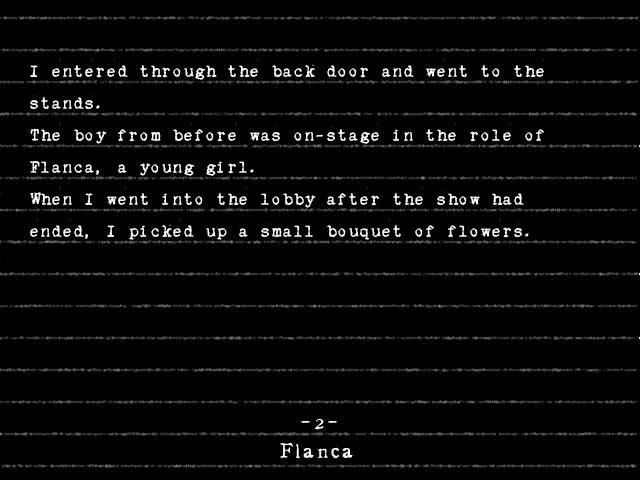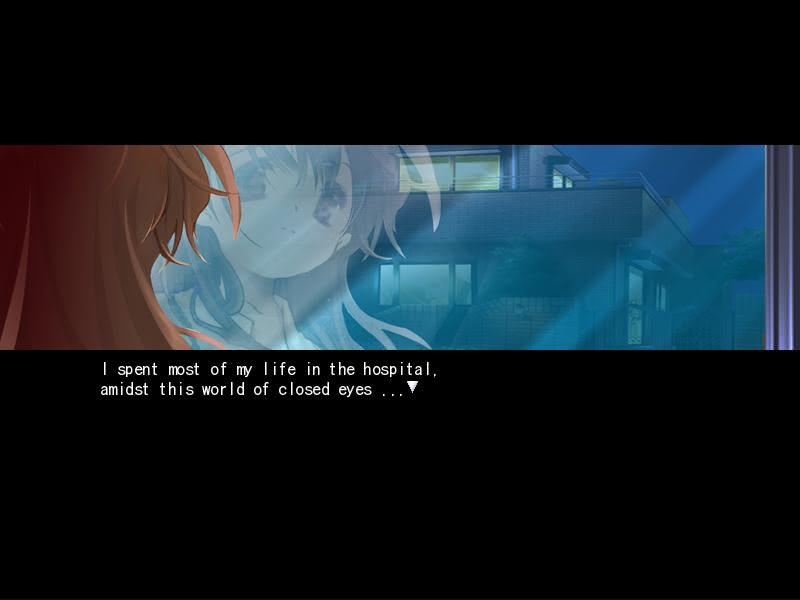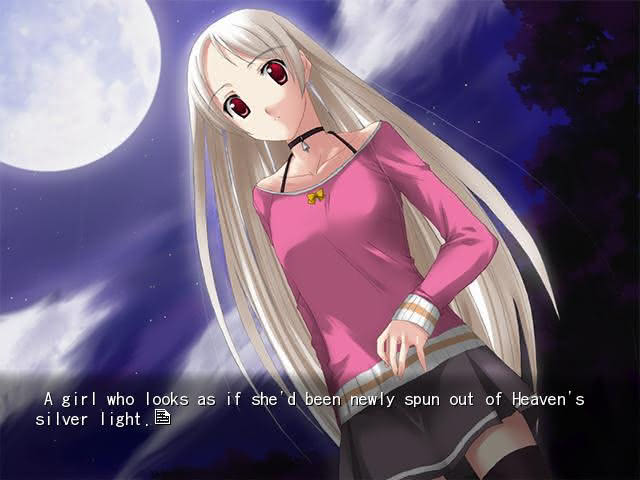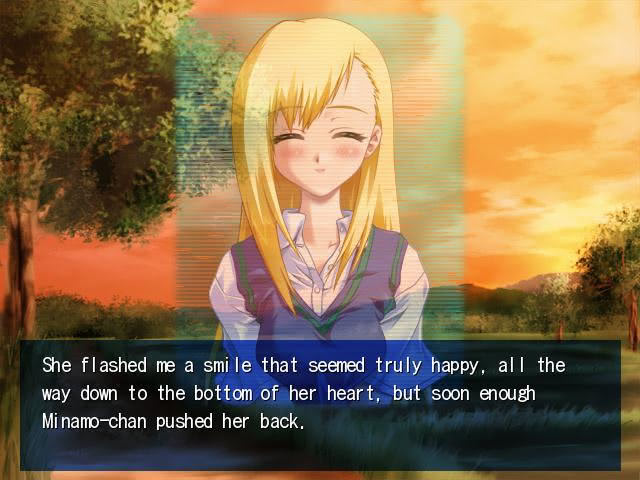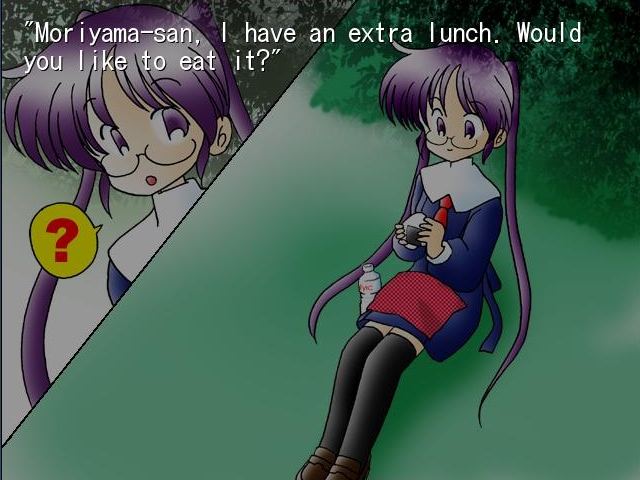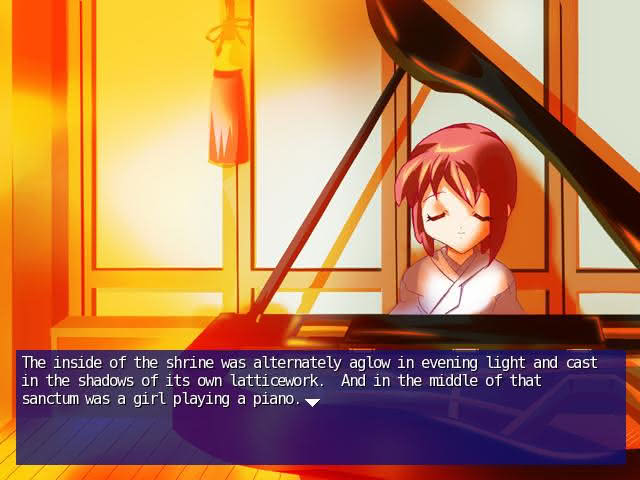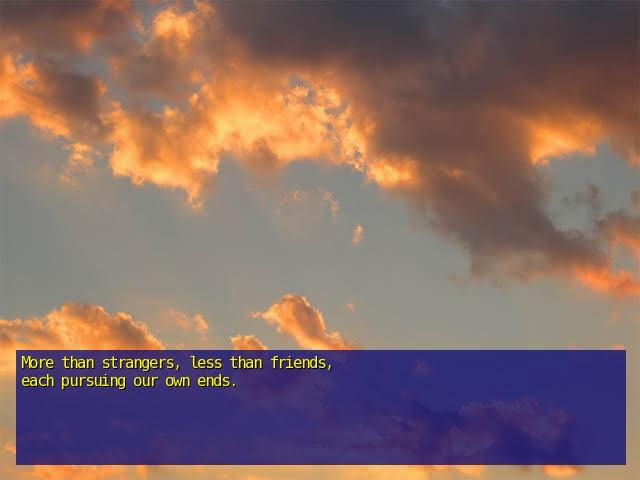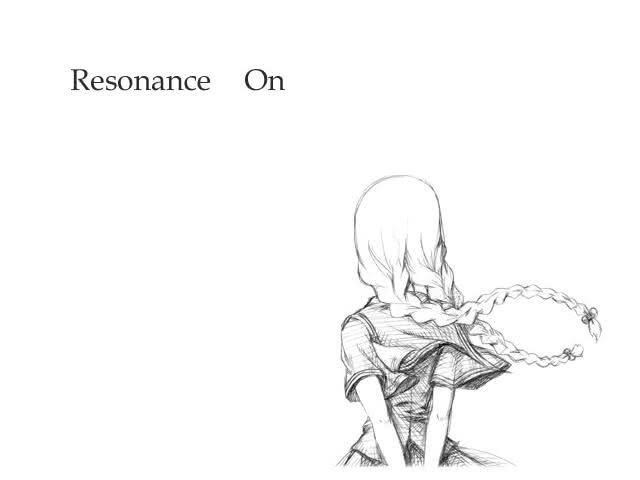31 Japanese doujin visual novels were translated into English and contributed to three translation festivals – al|together – which took place in 2005, 2006, and 2008. After writing full reviews of 29 of the 31 novels, I decided to rank all of the novels from 31 to 1. I ranked novels 31-21 and 20-11 in two previous articles. In this article, I present my personal ranking of the top 10 visual novels from al|together. Before reading, please see the earlier articles in the series, listed below:
- al|together Visual Novel Ranking Project Introduction
- al|together Visual Novels: 31-21
- al|together Visual Novels: 20-11
You can learn more about my al|together project by reading my project introduction article. That article includes a running list of our completed al|together reviews. I have a dedicated collection post with links to all of our al|together articles, including reviews, essays, and short posts.
Below, you will find a full list of the al|together visual novels, sorted by the translation festival they were contributed to. My top 10 novels are listed in bold and will be ranked in this article. Articles that were ranked between 11 and 31 have strike-throughs and link to their section in the previous ranking articles.
- al|together 2005: A Midsummer Day’s Resonance;
A Winter’s Tale (13);io [Christmas Eve] (25);I, Too, Saw Dreams Through Air (19); Narcissu;Plain Song (17);Plain Song Christmas Special (20);The Poor Little Bird (23);Until We Meet Again (11) - al|together 2006:
Adagio (28);A Dream of Summer (18);At Summer’s End (16); Collage; Flood of Tears;Instant Death! Panda Samurai (27);Midsummer Haze (31);My Black Cat (21);Night of the Forget-Me-Nots (22);OMGWTFOTL (26); Red Shift; Shooting Star Hill; Summer, Cicadas, and the Girl; The world to reverse.;Visions From the Other Side (24);Wanderers in the Sky (29) - al|together 2008:
Crimsoness (12);From the Bottom of the Heart (14);LEAVEs. (30); May Sky;Moonshine (15); The Letter
Just 10 novels remain. Let us begin the count-down from 10 to 1.
al|together Novel Ranking: 10-1
Note that for each novel in the ranking, I will include its ranking for its al|together year and its length-tier ranking. The length tier ranking shows how the novel in question compares against al|together novels of similar lengths. I explained the length tiers in the introduction. In general, the very short tier is for novels that take less than 20 minutes, the medium-short tier is for novels in the 20-50 minute range, medium short covers novels from 50 minutes to 2 hours, and long covers novels that generally take more than 2 hours.
10. The world to reverse.
We lead off our top-10 with the third of Circle 17’s al|together novels: The world to reverse. Like its second novel, I, Too, Saw Dreams Through Air, The world to reverse is actually two short and unrelated novels (they share a theme but are otherwise unrelated) bundled together.
- al|together 2006 rank: 6/16
- Medium-Short rank: 1/8
Both of the visual novels which make up The world to reverse are quite good, although the second, flanca, has a tenuous claim to being a visual or sound novel.
Novel Info
- hallucinate Summary: The view-point character wakes up in a hospital bed, unable to move. A woman with hate-filled eyes appears before him.
- flanca Summary: A protagonist in a plague-ridden town inspired by medieval Europe makes a series of choices. There are no truly happy endings.
- Festival Page: al|together 2006
- Translator: satsu
- Japanese Novel: The world to reverse. (2006)
- Original Developer: 17
- Engine: NScripter (JP); ONScripter (EN)
- VNDB Entry
- NLJ Review
Discussion
The two visual novels in The world to reverse are not directly related, so I will assess each in turn.
TWTR’s hallucinate is one of the most visually impressive al|together pieces, drawing everything almost in white and featuring a woman with sharp, striking red eyes. Its single soundtrack is haunting and creepy – which perfectly matches the fact that our amnesiac view-point character wakes up in a hospital bed and is being cursed by a woman who accuses him of having done something horrible. This short piece has a couple of choices which, depending on the player’s combination of answers, leads to four distinct endings with one being the good ending. The good ending reveals the novel’s clever twist which, while not impossible to foresee, is a good twist and follows logically from the entire set-up (pay attention to the title menu after the true end if you missed the twist in-game).
The second of TWTR’s novels, flanca – has a tenuous claim to being a visual novel. I dare say it is also not a sound novel since it has no sound. There are no visuals to speak of other than text on a lined, black background. Each run involves four choices and five scenes – and each choice is meaningful to unlocking one of the novel’s many endings. One could make the case that flanca is actually a quasi-text-based choose-your-adventure book. It exists somewhere between a visual/sound novel and a text-based game. As for the story, flanca takes place in an unnamed place that comes off as a plague-ridden town based on dark age/medieval Europe. The bleakness of the town is oppressive, and the characters encounter few reasons for hope or optimism en route to what is almost always an unfortunate ending for one reason or another.
Both halves of The world to reverse are memorable in different ways. The first novel, hallucinate, makes full use of the medium to deliver a creepy atmosphere. The second, flanca, tells a genuinely interesting – albeit depressing – story in a quasi-choose your adventure format, omitting sound and any visual flourishes. Both are quite good and my opinion of TWTR improved the more I thought about it.
9. Summer, Cicadas, and the Girl
The young man who serves as the view-point protagonist meets a flighty, whimsical girl on a hot summer day. What starts as a generic visual novel has an interesting, interactive twist.
- al|together 2006 rank: 5/16
- Very Short rank: 1/8
Cicadas is the shortest novel in our top 10 and, in my final analysis, the best “very short” novel of al|together.
Novel Info
- Short Summary: A young man spends an afternoon with a strange young lady and is left to guess where she will be the next day.
- Festival Page: al|together 2006
- Translator: Shii
- Japanese Novel: Natsu, Semi, Shoujo (2005)
- Original Developer: KaTana
- Engine: KiriKiri 2 / KAG 3
- VNDB Entry
- NLJ Review
Discussion
Summer, Cicadas, and the Girl has a very pedestrian, generic story – and the base novel can be read in 3-5 minutes. It is visually simple – although it is worth noting it has some specific (and welcome) visual flourishes that set it apart from all of the other al|together novels. Reviewing the final product – I will note that there are a couple of examples of clunky English dialogue.
The reason Summer, Cicadas, and the Girl finds itself in my top 10 is because of its central mechanic. After the protagonist spends the day running around with an exhausting girl he just met, he is left to guess, from a small number of clues, where she will be the next day. Instead of offering a choice, the player is given a text box. There are many acceptable inputs, and each acceptable input leads to one of a surprising number of endings. However, only one input leads to the good, true ending. Each wrong choice unlocks an extra scene featuring the two characters having discussions that tie into solving the mystery in the main story. The sixth and final of these scenes makes the answer to the game’s small mystery obvious for those who do not figure it out beforehand.
Cicadas is a fun, feel-good novel. Nothing about it beyond its mechanic is unique, but despite only knowing its two characters for a short time I found myself rooting for them by the time I solved the mystery. The charming good end felt rewarding after reading through the story and viewing all the clues to reach the correct answer. There is something to be said for a feel-good piece that is as fun as it is simple. Anyone interested in making visual novels or games should take the time to play through Cicadas and take notes.
8. Narcissu
The most well-known novel in the West to come out of al|together is among the most depressing (rivaled only by TWTR’s flanca). This is the story of a small journey undertaken by two terminally ill young adults.
- al|together 2005 rank: 2/9
- Long rank: 5/7
Narcissu was the first al|together translation and the only one that features two different translations of the same script.
Novel Info
- Short Summary: Two terminally ill young adults who feel like the world has left them behind go on a journey.
- Festival Page: al|together 2005; Insani’s Narcissu site
- Translator: Seung Park and Peter Jolly (separate translations)
- Japanese Novel: Narcissu (2005)
- Original Developer: Stage-nana
- Engine: NScripter (JP); ONScripter (EN)
- VNDB Entry
- NLJ Review
Discussion
My review of Narcissu went into some of the issues I have with its script. But despite my noting some negative points, Narcissu is one of the best written and translated stories in al|together, and despite its visual minimalism, it rivals A Dream of Summer, A Winter’s Tale, Collage (not yet ranked), LEAVEs, Moonshine, and Until We Meet Again for having the best production values of al|together in both the audio and visual spheres. Its voice acted version features the best voice acting of any al|together novel (admittedly a small sample).
My caveats aside – Narcissu is a novel that cares about its two terminally ill characters. Especially in its co-protagonist Setsumi Sakura, it offers a visceral depiction of the terminally ill woman for whom time has stopped, the world is left behind, and who has little to do beyond picking up idle facts and thinking about how she will die. It is clear from the start of Narcissu that this is not a story that will have a happy ending. It is, instead, a story that asks readers to empathize with two characters who know what their ultimate ending – most likely not in the distant future – will be. I described my 14th ranked novel, From the Bottom of the Heart, as the epilogue to a story centered on terminal illness that we were never told about. Narcissu, on the other hand, is a long novel focused almost exclusively on the story of a terminally ill young man and woman – but most pointedly on the woman – who feel forgotten as they wait for the end.
Narcissu is not a perfect piece, but its recognition over the years is well-deserved. Unlike other al|together novels, Narcissu is available for free on the most popular online game marketplace, Steam (the Steam version is a little different but you can read it with one of the two al|together translations, thus getting about the same experience).
7. Flood of Tears
A Kanon-inspired piece with a winter setting and aesthetic that features a goofy school boy, his classmate and childhood friend, and a mysterious, standoffish girl who catches his eye.
- al|together 2006 rank: 4/16
- Long rank: 4/7
Flood of Tears is technically one of two “precursor” submissions to al|together 2006.
Novel Info
- Short Summary: Tarou Yamada, a middle school boy, spends his days chatting with his best friend, Hina Kawase. He must decide whether to hang out with Hina or get to know a new classmate, Umi Shinoyama.
- Festival Page: Insani (no page on al|together 2006 site)
- Translator: Seung Park
- Japanese Novel: FLOOD OF TEARS (2001)
- Original Developer: TMS
- Engine: NScripter (JP); ONScripter (EN)
- VNDB Entry
- NLJ Review
Discussion
Flood of Tears is a lovable mess. It is a long novel by al|together standards and it features a significant number of choices, albeit the results of two of the choices places the player on the routes of one of the novel’s two heroines Hina Kawase or Umi Shinoyama, while other choices lead to a bad ending. The endings to the Hina and Umi routes resolve the novel’s down to Earth story while leaving many other questions unanswered. I will venture that one reason the novel leaves some matters unexplained is because the writers did not have an explanation for them.
But Flood of Tears is good.
Hina Kawase, one of the two heroines in Flood of Tears and the centerpiece of one of the novel’s two routes, is the most fun character in al|together and, for my money, the best character in a strong field. She is the best friend of the goofy view-point character, Tarou Yamada. While we have looked at several novels that featured childhood friend relationships (see e.g., 16th place At Summer’s End and 13th place A Winter’s Tale), Tarou and Hina are the most charming. Hina clearly enjoys spending time with Tarou while being exasperated by the weird things he says. Conversely Hina, who is often serious by comparison to Tarou, proves to have passionate opinions about things Tarou finds silly. Their ribbing is always in good fun and the well-translated dialogue conveys that they get along well and have a natural rapport. Hina is written convincingly for a middle school girl, and as I noted in my review, she is a character the reader can imagine being a good friend. Umi is standoffish and mysterious. Her route and character compare unfavorably to Hina, but taken in isolation, she ultimately has a solid story and decent enough route. This saves it from being another A Dream of Summer case with one solid route and one weak route.
Flood of Tears has what I would describe as a potentially divisive visual style, but it grew on me over the three-or-so hours of reading. Hina is well-designed, albeit it has some knockoff Key vibes to its art, and the oily backgrounds have enough variety to keep things fresh.
Flood of Tears excels as a character piece and, despite leaving many unanswered questions, establishes both Hina and Umi (especially Hina) well enough that the endings are effective. Had it done more to think through what I will vaguely describe as its sci-fi plot, Flood of Tears could have threatened the top of the ranking.
6. The Letter
The Letter is one of the more serious, understated, and down-to-Earth al|together novels. We have a young man in college returning home to visit his mother and – through the clever use of an arguably sci-fi plot thread – reflections on family.
- al|together 2008 rank: 2/9
- Medium-Long rank: 3/8
The al|together version of The Letter translates the second release of the game, which was written in NScripter. The original was built with Yuuki!Novel.
Novel Info
- Short Summary: A young man in college returns home for the first time in a couple of years while feeling strangely disconnected from the place he grew up.
- Festival Page: al|together 2008
- Translator: Seung Park
- Japanese Novel: Tegami (2007) [see article]
- Original Developer: P.o.l.c.
- Engine: NScripter (JP); ONScripter (EN)
- VNDB Entry
- NLJ Review
Discussion
The Letter is one of the most minimalist novels of al|together. Its visuals consist of text on modified photographic backgrounds. To its credit, it makes excellent use of its freeware soundtrack and is well above average on the sound front. The Letter is the most minimal novel in my top-10, and it features no meaningful choices.
The Letter offers a nice, down-to-Earth, and well-written story. The protagonist, Takahiro Watanabe, is a young man in college returning to his small town home to visit his mother for the first time in a couple of years. This triggers in him memories of his father, who had been a police officer and died in a car accident when Takahiro was young. As he returns home, Takahiro ponders how he feels disconnected from his home and his family – despite being welcomed home by his mother, who he notes is growing older. A certain experience which is handled very deftly and cleverly makes Takahiro think more about his past, his memories of his father, and the time spent with his mother. The Letter is, in the end, a nice story about family and appreciating one’s family while one is still able to.
The Letter fits into the al|together 2008 theme of isolation in mid-2000s Japan, but it does so in a more subtle way than do pieces like LEAVEs and Moonshine. At its heart, The Letter is a sentimental piece – and one in which the protagonist finds some answers to address his unease and a perspective that will help him going forward. To the extent it throws in an arguably sci-fi plot in its second half, it does so well and in a way that I think is perfectly intelligible. The Letter is simply presented and consistently understated.It is well-written, delivers an excellent message, and concludes in a neat and on-point manner.
5. Red Shift
Red Shift is another long (by al|together standards) piece centered on the interactions of a high school boy and a hot-headed albino girl. It becomes clear that there is more to the girl than meets the eye.
- al|together 2006 rank: 3/16
- Long rank: 3/7
Red Shift is the second of two al|together 2006 precursor submissions after Flood of Tears, which I ranked seventh. The al|together 2006 precursor selection was strong.
Novel Info
- Short Summary: A high school boy meets a tsundere albino girl in a local park in the evening.
- Festival Page: Insani (no al|together 2006 page)
- Translator: Seung Park
- Japanese Novel: Tokoyo no Hoshizora (2005)
- Original Developer: Team Extra
- Engine: NScripter (JP); ONScripter (EN)
- VNDB Entry
- NLJ Review
Discussion
We see Red Shift from the perspective of Kouya Ayakawa, an introspective 17-year old protagonist who tends to say what is on his mind. One evening, he encounters an albino girl named Mikoto in a park. Mikoto, despite appearing to be close to Kouya’s age, is immature and temperamental, albeit she seems to want to talk to Kouya. It becomes clear that there is something a bit off about Mikoto, and that it likely relates to a mysterious phenomenon experienced by Kouya near the park and a mysterious girl he meets during that phenomenon. Of course, this is a spoiler-free review, so I cannot go into specifics.
Red Shift reads very well in English (one of the best of the set) and is impressively consistent for being a long novel with a single writer. I faulted it in my review for being too slow at the start and introducing a few tropey, unnecessary points that ultimately had no bearing on anything – but both of those issues are minor and forgivable. It has an interesting visual presentation, giving Mikoto and two other characters full portraits by using little head-shots in the text boxes to show their emotions. While this introduced some disconnect – it ultimately worked. Moreover, Red Shift has some excellent CG scenes and genuinely pretty white and blue chapter cards featuring Mikoto.
Red Shift was always destined for a strong ranking, but it was pushed into my final top five by its ending. Where many al|together novels got off to intriguing starts and lost momentum as they inched toward their conclusion, Red Shift proved to be a novel with a clear idea from the start that it developed throughout the story. I can forgive it for starting slow because it was ultimately a story told with purpose – articulating its central message in its climax and then delivering on it in a sharp way that made for one of the best conclusions of an al|together novel.
4. A Midsummer Day’s Resonance
This is the story of a certain summer in the life of Kasumi Kurasawa, a slightly depressed high school freshman, and the remarkable events that bring with them new feelings.
- al|together 2005 rank: 1/9
- Medium-Long rank: 2/8
Resonance also has some fun post-game Easter eggs for unlocking extra content, including the creator’s commentary.
Novel Info
- Short Summary: Kasumi Kurasawa is an ordinary first-year high school girl who feels unease about growing up. After her phone breaks on account of an accident, it begins projecting the holograms of two other girls who are close to Kasumi’s age. So begins the story of a certain summer.
- Festival Page: al|together 2005
- Translator: Seung Park
- Japanese Novel: Natsu no Hi no Resonance (2002)
- Original Developer: Saitou Kagura
- Engine: NScripter (JP); ONScripter (EN)
- VNDB Entry
- NLJ Review
Discussion
A Midsummer Day’s Resonance is the most distinctly feminine al|together novel, being one of only six to exclusively or primarily use a female view-point character and being the only one to focus on the character development of an adolescent (in this case 15-year old) girl. The only reason I hesitate slightly in describing Flood of Tears’ (7th place) Hina Kawase as the best character of al|together is because the central protagonist of Resonance, Kasumi Kurasawa, makes a compelling case for herself. However, where Hina is the central character of one of two routes of Flood of Tears and we always see her through the eyes of a different character, we spend the entirety of Resonance with Kasumi and her thoughts.
Kasumi is an entirely normal 15-year old girl with no unusual traits or great drama in her life. Kasumi’s stand-out trait is invisible to those around her – she is very introspective (arguably to a fault) and self-conscious. From Kasumi’s monologues, we learn that she feels unease about existing in a particular place where she is neither a child nor an adult, but is moving irrevocably toward being an adult regardless of whether she wants to or not. Kasumi suffers from general malaise and admits to being lonely after having grown apart from her childhood friends despite still going to the same school.
What sets Kasumi apart from many similarly situated male protagonists in Japanese visual novels, anime, and related media is that, while she is probably slightly depressed, she is not disaffected. Kasumi is open to something exciting happening that would change her perspective. She is in luck when a hologram of a high school girl close in age to her emerges from her broken phone, which suffered an unfortunate series of events tied to a boy on a bike. Kasumi finds herself able to communicate with the first hologram girl and a second hologram girl with some regularity, and she finds herself falling for the second girl – which provides her with some excitement and something to look forward to. Resonance stays laser focused Kasumi’s feelings about change and growing up and it has one of the stronger conclusions of any al|together novel.
Resonance is one of the best-written al|together novels and one of the best translated – I credit Mr. Seung Park of Insani for delivering an English script which portrays Kasumi’s character very credibly. It has its faults – one of the two two hologram girls can be grating – but this is, on the whole, one of the most consistent al|together scripts. Resonance is also helped by having above-average production values. Its background selection errs on the sparse side, but both of the hologram girls have strong portraits (they blink!), and I credit the novel for confining text to a text box. It also features some very pretty chapter cards of similar quality to those in Red Shift, most often featuring Kasumi.
For all of its strong qualities, A Midsummer Day’s Resonance stands as the best of the nine visual novels contributed to the inaugural al|together 2005 festival.
3. Shooting Star Hill
There are high school romances. There are science fiction visual novels. Shooting Star Hill asked “why should we choose just one genre?” But despite the many goings on, this is the story of extending kindness to someone in need of it.
- al|together 2006 rank: 2/16
- Medium-Long rank: 1/8
Shooting Star Hill stands as the best of my medium-long novel length tier.
Novel Info
- Short Summary: A high school transfer student goes all in on befriending an ostracized girl in his class who is derided as an “alien” by her classmates.
- Festival Page: al|together 2006
- Translator: Kawatori Shinji
- Japanese Novel: Hoshi no Furu Oka (2005)
- Original Developer: Ebi Shuumai II
- Engine: NScripter (JP); ONScripter (EN)
- VNDB Entry
- NLJ Review
Discussion
One reason that I have repeatedly made a point of explaining that my ranking is not a translation ranking is is exemplified in the complicated case of my second runner-up in the al|together ranking, Shooting Star Hill. The prose in the Shooting Star Hill translation is generally solid, but there are moments of clunky phrasing that have a tendency to occur in key points of the story. It has more examples clunky phrasing than any other novel in my top-eight. But does that make it a bad translation/localization? I think not. While the phrasing would have ideally been smoother at points, it is clear that the translator had command of the script in producing an English text with a clear message delivered in a clever way. The translator noted that he had worked directly with the author of the original novel – and I dare say it likely shows in the final product. I leave it to others to determine how to evaluate a translation that has some occasional shortcomings in style but conveys the translator’s clear mastery of the novel’s overall plot and structure. As a final product, Shooting Star Hill did more than enough to land in third place out of the 31 al|together translations in my final ranking.
The view-point character in Shooting Star Hill is a high school boy named Chihiro Naruse who transfers to a new high school at the start of the school year. Before his first day of class, he sees a girl crying at after a science fiction movie that he he had gone to the theater to see. It turns out – surprise! – that the girl, Kana Moriyama, is Chihiro’s classmate. Chihiro learns quickly that Kana is viewed as an outsider by the class and that many of her classmates derisively call her an alien. However, Chihiro is undeterred – and does his utmost to befriend the shy, taciturn Kana. While his initial efforts are unsuccessful, Chihiro eventually succeeds in breaking the ice and making friends with Kana, despite her concern that his being associated with her is not in his best interest.
Lurking behind everything in Shooting Star Hill is a sci-fi plot. This is not the proper setting to dive into things too deeply (I wrote a detailed analysis for people who read the novel), but there are signs that there may be something to the mean-spirited teasing that Kana receives for supposedly being an alien. What makes Shooting Star Hill an impressive piece is that its sci-fi plot, to the extent it has one, is seamlessly woven into the narrative. By this I mean that one could read it as metaphor and find that everything describes Kana’s real-world loneliness and alienation perfectly. This stands in stark contrast to my seventh-ranked al|together novel, Flood of Tears, which failed to connect and fully reconcile its down-to-Earth and not-so-down-to-Earth plot-lines. Shooting Star Hill is, at its heart, the story of a depressed, lonely girl who has been dealt an unfair hand by those around her, and the boy whose heart she inadvertently captures who shows her a great deal of kindness. It builds up to a final choice (and the only meaningful choice) which tests whether the player, acting as Chihiro, understands the heart of Shooting Star Hill. Its conclusion is the best of the 31 al|together novels.
Shooting Star Hill has a unique and charming visual style. All of the characters have a unique, endearingly cartoonish look that pops from the generic photographic backgrounds. The novel makes up for its general simplicity with a large number of pretty, fully drawn CG scenes, and it gives the novel’s heroine, Kana, a significant number of outfits.
Shooting Star Hill has undeservedly middling review scores from players on Visual Novel Database. For my part, I hope that my review project shines a light on a very under-appreciated novel that deserves much more exposure.
2. Collage
A working woman quits her job, meets an old high school classmate, and unknowingly sets off a series of events in a real-world, mid-2000s Japan setting.
- al|together 2006 rank: 1/16
- Long rank: 2/7
Collage lives up to its name in more ways than one.
Novel Info
- Short Summary: A newly single and unemployed career-woman reconnects with a high school classmate which leads to new and unexpected connections.
- Festival Page: al|together 2006
- Translator: AstCd2
- Japanese Novel: Collage (2004)
- Original Developer: Komineto
- Engine: KiriKiri 2 / KAG 3
- VNDB Entry
- NLJ Review
Discussion
Collage is the most ambitious of the 31 al|together novels and the most unique in its subject matter.
The long novel, which should take most readers somewhere in the neighborhood of four hours to read, is ultimately told from three perspectives. The first of the three narrators, Yuuko Sasaki, stands princes inter pares. She is a woman most likely approaching 30 who had just quit a job she hates. Somewhat depressed after the event, she runs into a former high school classmate at a bar which leads to them catching up. This triggers a series of events wherein Yuuko finds herself dragged into editing a magazine for a town festival and her path crosses with people from her past and people whom she had not previously met. As the story expands and we see the same events from different angles, a web of interconnected connections between all the characters and their stories are ultimately revealed.
Collage is very much a slice of life piece. There is drama, but it arises from the novel’s many characters crossing paths and trying new things. There is no single dramatic event or over-arching plot. To the extent Collage has a message, the message is to attend to those around you, maintain connections and make new ones, and be open to trying new things to find a path forward.
While Collage stands out for being a novel about adults making their way in mid-2000s Japan, it has other points that set it apart from the al|together crowd. Its visual style is very unique and fits the name Collage, with the screen being broken into several sections which show the player the narrator, chapter number, current music track, scene, and text box. While the scenes are depicted with nothing other than photographic backgrounds, Collage has a remarkable number of backgrounds, taking care to, for example, use different backgrounds for different coffee shops, tea houses, and diners that appear throughout the long story. The freely available music tracks reminded me greatly of Persona 3 and fit the novels distinct mid-2000s urban aesthetic. The novel benefits from the expert translation style of AstCd2, who was behind my favorite reading translation, A Winter’s Tale. Collage also reads very well.
Another interesting point of Collage is its choices. It features many survive-and-advance choices wherein there is one right answer to continue the story and one answer that leads to a game over – noting some of the game over scenes reveal points about the plot. The choices are not difficult so long as one remembers the message of Collage, but they add some variety to what would otherwise be a purely kinetic novel.
Collage is one of two novels I considered for the top spot. It takes top marks for style and complexity, but it had some minor blemishes that held it back. While all three narrators are strong, Yuuko is the most compelling and the third is not as well developed as the second, much less Yuuko. While the ending is acceptable, it felt like Collage could and should have done more with it. Collage may have benefited from having another in-game week or two, but it is already quite long for this sort of project. On the whole, Collage is an excellent visual novel separate from being an interesting piece of doujin translation history and one that I would love to see re-released in a format that makes it easier for people to enjoy.
1. May Sky
The best novel of al|together is the story of a young trainee at an office and his strange, hard-to-define relationship with a mercurial shrine girl who plays the piano.
- al|together 2008 rank: 1/6
- Long rank: 1/7
Now for our discussion of The New Leaf Journal’s (i.e., my) choice for the best of the 31 al|together visual novels.
Novel Info
- Short Summary: A malaise-ridden 22-year-old office trainee develops a peculiar relationship with a lazy 16-year old shrine girl who enjoys playing the piano.
- Festival Page: al|together 2008
- Translator: Irene Ying and Seung Park
- Japanese Novel: Gogatsu no Sora. (2005)
- Original Developer: Scrubbing
- Engine: NScripter (JP); ONScripter (EN)
- VNDB Entry
- NLJ Review
Discussion
al|together 2008’s May Sky, originally created by circle Scrubbing and translated by Mr. Irene Ying of Insani under the supervision of Mr. Seung Park, is the best of the 31 visual/sound novels contributed to al|together.
Almost all of May Sky is seen from the perspective of Haruki Mizoguchi, a depressed, self-involved 22-year old salary man in training. In May, he is sent to the proverbial boonies for training where he encounters a 16-17 year old shrine maiden named Minori Kamiake, whose piano playing inspires the novel’s al|together-best soundtrack.
Haruki and Minori develop an odd relationship, spending time talking at the shrine – a place seemingly separate from the rest of the world. Haruki is melancholy, introspective, indecisive, and dreading the thought of his entire life being spent consumed by a dull job. One can quickly question his maturity when he decides that the person to confide his problems in is a high school shrine maiden. For her part, Minori is amusing and has moments of aesthetic inspiration. However, Minori is also selfish and blunt, leading one to understand why this high school girl seems to have little better to do than bicker with Haruki. Much like the characters in other al|together 2008 pieces, both Haruki and Minori feel estranged from the world and people around them – which is what brings them together. The most common refrain of the novel is more than strangers, less than friends. Their relationship and openness with one another is defined by the feeling that their connection exists in a small space separate from their real lives.
The entirety of base May Sky takes place in a certain May (the name is on point). It is a romance story in the end – albeit there is little romance subtext, much less overt text, until late May. To the extent it is a romance, it is one that has roots in Haruki’s immaturity and Minori’s standoffishness. May Sky is very carefully written – and we see subtle character development in both Haruki and Minori as they get to know each other over the course of a certain May. Noting that I used the term base May Sky, the novel has a post-completion epilogue which is about half the length of the base story. While this is not the forum to discuss the epilogue, it takes place after time has passed since the May that gave May Sky its name and focuses on a new dynamic between Haruki and Minori. The epilogue, like the base game, is very good – and without it May Sky would not be the top novel of al|together.
May Sky has the most minimal visual presentation of the top five. It features modified photographic backgrounds and the only character who has a sprite is Minori. Minori’s sometimes-noseless look takes some getting used to – but she grew on me over time much like Ayaka in At Summer’s End (Minori is a bit better designed than Ayaka). I appreciated that the novel opted to confine text to a text box, although some styling would have been welcome. May Sky features a solid selection of CG scenes to add some variety to the visuals, albeit they are not on the level of fellow-top five novels Red Shift and Shooting Star Hill. However, where May Sky lacks somewhat in visuals, it has an excellent – for my money al|together-best – soundtrack, which fits the theme of Haruki and Minori meeting because Haruki followed the sound of her piano.
May Sky makes for compelling reading from beginning to end – and the conclusions to its base story and epilogue are both strong. Both Haruki and Minori are flawed – more obviously so than most similarly situated al|together protagonists – but their dialogue and subtle character development make for good reading. Much as Haruki’s and Minori’s relationship could only develop in a specific place, the shrine, at a specific time, during Haruki’s assignment – May Sky is, to its benefit, very much a piece rooted in mid-2000s Japan. There were many compelling novels translated to al|together – but none put everything together as well as May Sky. Thus, I offer my belated congratulations to circle Scrubbing for making the original Gogatsu no Sora and Insani for producing what turned out to be the finest novel to come out of the al|together festivals.
Conclusion
This, along with my category awards piece, brings my al|together ranking project to a close. While I liked many of the novels all the way down to the top ones in the first leg (31-21) of the three ranking articles, the top 10 represented what for me were the cream of the al|together crop. Much like Pokémon is fond of Elite Fours, this ranking definitely had an elite four, with there being some distance between 4th place A Midsummer Day’s Resonance and 5th place Red Shift. Resonance featured what was the best character examination of al|together. Shooting Star Hill had the clearest theme and cleverest delivery of its message – and had it been cleaned up a bit, it may well have been the best piece of the festival. Collage was one of the only two novels I ultimately considered for the top ranking – and it may well have grasped it had its latter sections and conclusion been stronger. But in the end – there could only be one choice for the best novel of al|together. May Sky is the longest novel of the collection and is consistently excellent from beginning to end, developing its two flawed characters carefully and deliberately. The terrific Narcissu is the best-known al|together novel, Collage was the most creative entry, but having played all 31 submissions to the festivals – I am content with my assertion that May Sky, an entry in the last al|together festival, is the finest English piece to emerge from the three festivals.
In addition to shining a light on the great translation efforts and creative Japanese doujin novels of the mid-2000s, I also hoped to find a few lesser-known gems. While Narcissu did not need any extra publicity from me, the other nine novels in the top 10 are comparatively less well known, at least in the United States. I hope that my list and reviews inspire some readers to solve the little mystery presented by Summer, Cicadas, and the Girl, befriend Flood of Tears’ Hina Kawase, join The Letter’s Takahiro Watanabe in reconnecting with his home, extend a hand to the lonely Kana Moriyama in Shooting Star Hill, and spend May with the pair of acquaintances in May Sky, and check out many of the other al|together novels that I reviewed. I also hope that while reading and playing these novels, people take a moment to appreciate the effort that went into their original creation and translations, all of which was done with no expectation of financial gain.

